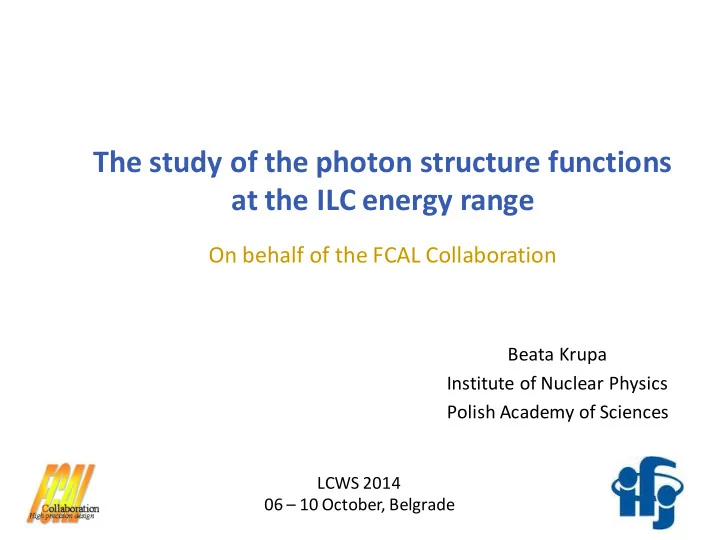

The study of the photon structure functions at the ILC energy range On behalf of the FCAL Collaboration Beata Krupa Institute of Nuclear Physics Polish Academy of Sciences LCWS 2014 06 – 10 October, Belgrade
Outline ● Motivation 𝛿 structure function ● Measurement of the 𝐺 2 ● Expectations for ILC/CLIC ● The first results for the photon structure function 2
Two-photon processes – a powerful tool → collisions serve as the prototypes of collisions of the other gauge bosons of the Standard Model. → Tests of electroweak theory in photon-photon annihilation ( → W+W-, → neutral & charged Higgs bosons; higher order loop processes → , Z , HZ 0 and Z) → The high energy and e collisions – tests of QCD. → Two-photon production of supersymmetric squark and slepton pairs. → The e collisions allow the study of the photon structure function. → … Two-photon processes ( , * , * * events) provide a comprehensive laboratory for exploring virtually every aspect of the Standard Model and its extensions. 3
Is the study of photon structure important? In spite of many studies of the photon structure, still it is needed to bring our understanding of the photon to the same level as HERA has achieved for the proton. This will offer new insights in QCD. • As the beam energy at the ILC/CLIC will be higher, it is expected that it will be possible to measure the evolution of the photon structure function in a wider range. • The experimental measurement of the structure function for virtual photons is up to now a difficult task (the interaction of two virtual photons is a ‘golden’ process to study the parton dynamics – DGLAP and/or BFKL). • The possibility of tagging both electrons would allow to measure W 2 independently of the hadronic final state. • A new light on the photon structure could be shed by spin-dependent structure functions, which have not been measured so far – this would be possible in the polarized e + e - collisions in the future linear collider. 4
Photon structure function & its measurement The single-tag process e + e - → e + e - X tag = 2𝜌𝛽 2 𝑒𝜏(𝑓𝛿 → 𝑓𝑌) 𝛿 𝑦,𝑅 2 − 𝑧 2 𝐺 1 + 1 − 𝑧 2 𝐺 𝛿 (𝑦,𝑅 2 ) 𝑦𝑅 4 ∙ 𝑒𝑦𝑒𝑅 2 2 𝑀 anti-tag x i – fraction of parton momentum with respect to the target photon y ei – energy lost by the inelastically scattered electrons ′ ) – energy of the beam electrons 𝐹 𝑐 ( 𝐹 𝑗 (the scattered electrons) 𝐹 ℎ ( 𝑞 ℎ ) – energies (momenta) of final state particles P 2 = Q 22 Virtuality of the target photon All presented further results relate to the PYTHIA generator level 5
Photon structure function Deep inelastic e γ scattering Analogy with studies of the proton structure functions at HERA HERA LC Possible synergy with HERA studies 6
Expected values of kinematic variables LumiCal 31 – 78 mrad ILC BeamCal 5.8 – 43.5 mrad LumiCal 38 – 110 mrad CLIC BeamCal 10 – 40 mrad 7
Expected values of kinematic variables For LumiCal, the accepted angular range cover 31 – 78 mrad and the mean value of y is less than 0.12 F L term can be neglected. 8
Expected values of kinematic variables Weak dependence of the x distribution on P 2 cut . In real experiments (like those at LEP) the value P 2 = 0 was often used. 9
Event selection At first we are concentrating on single-tagged events with electron measured in LumiCal. The optimal choice of the event selection should include cuts like : An electron candidate observed The W vis will be reconstructed from tracks with energy E tag > 0.7E b and polar angle measured in tracking detectors together with in the range 31 < θ < 78 mrad. energy depositions – clustrers in electromagnetic and hadronic calorimeters No deposited energy with value E a > 0.2E b of the main detector ILD in the detector on the opposite side (an anti-tag cut applied for possible electron candidates in the hemisphere opposite to the tag electron) – low virtuality of the quasi-real photon At least 3 tracks originated from the hadronic final state have to be present The visible invariant mass W vis of the hadronic system should be in the range 3 GeV 2 < W vis < 0.6 E b The upper limit should reduce expected background of annihilation events. 10
Photon structure function PYTHIA Monte Carlo studies e + e - e + e - * + - e + e - e + e - * hadrons 𝑅 2 = 119 𝐻𝑓𝑊 2 𝑅 2 = 119 𝐻𝑓𝑊 2 possible The expected dominant background : e + e - e + e - + - background : Z 0 / hadrons These processes as possible background will be studied in the next step of analysis 11
Summary and Outlook ● Information from LumiCal detector can be used to study the photon structure function. ● To extend the range of x and Q 2 variables other detectors like BeamCal, ECAL should be used. ● At ILC/CLIC it will be possible to move the upper limit of Q 2 towards higher values. ● It is necessary to consider the background (beamstrahlung, annihilation, etc.). ● The PYTHIA generator level results will be compared with other available Monte Carlo generators: WHIZARD, HERWIG as well as those used in LEP experiments after their adaptation to ILC/CLIC conditions: PHOJET, TWOGAM, BDK, … ● The next steps towards of the complete analysis will include: the use of the reconstructed variables and the estimation of systematic effects, including background. 12
Recommend
More recommend